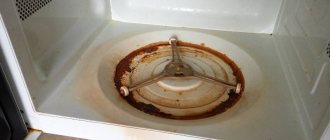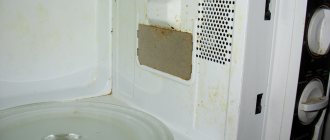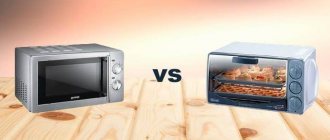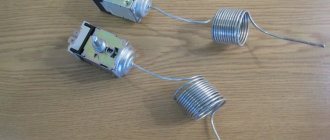What can cause sparks to appear?
When a microwave oven sparks, there are always additional nuances that indicate serious problems inside the device. This includes a grinding sound, a burning smell, and a characteristic crackling sound inside the device.
If sparks appear inside the microwave immediately after turning it on, then in the absence of other signs, most likely the problem is the following:
- You installed dishes made from prohibited materials inside and turned on the appliance. Often the microwave sparkles because of metal or patterned utensils, as the paint contains metals.
- The mica plate may have failed.
- The coupler is faulty.
- The inner enamel is rusted, cracked and peeling.
- Failure of the socket, plug or cord of the device.
Important ! Any of these reasons can cause serious damage to the device. If you find that the equipment is sparking and cracking inside, you should immediately repair the damage by contacting a household appliance repair center. You can also try to repair the device at home, provided you have experience in such matters and follow safety rules.
Prohibited utensils
If the microwave oven sparks inside, this means that you or someone around you has neglected the rules for operating the device. A universal rule for all microwave appliances is that the use of any metal utensils is prohibited. Careless handling of the device can not only lead to sparks, but also to a fire.
Reference . When the microwaves from the magnetron cannot pass through the food and are reflected from the surface of the metal cookware, an increased discharge of electricity occurs (sparks and crackling sounds). This is the main cause of malfunctions.
But not only cast iron, enameled, brass and all other metal containers are prohibited for heating food in the microwave.
There are a number of other restrictions:
- no plates with gilding;
- Crystal dishes, due to their homogeneous structure, are capable of bursting from the action of microwaves;
- disposable plastic tableware melts under the influence of temperature, like cling film;
- aluminum pans are also not suitable for heating or baking;
- any cracked plate or cup is capable of bursting.
To avoid dangerous situations, it is recommended to use special dishes or those that are approved for heating:
- Heat-resistant glassware. Such utensils will serve not only for preparing dishes in a microwave oven, but are also suitable for the oven.
- Plastic dishes. An important condition here is that the plastic must be of high quality, otherwise it will simply melt under the influence of temperature.
- Porcelain dishes without high sides and with an open lid.
The simple rules described above will extend the life of your equipment.
Mica plate
The reason why a microwave shorts out in 90% of cases is a burnt section of mica located on the inner wall of the device. A plate made of sheet mica transmits microwaves from the emitter and protects it from splashes of fat, pieces of food and other contaminants. In addition, it protects other parts of the microwave oven from high temperatures and distributes microwaves evenly.
Reference . The magnetron antenna emits waves in the waveguide chamber, which is closed by a lid (plate) with accumulated dirt, while greasy spots begin to burn and as a result, a discharge of electricity appears between the burning mass and the wall of the microwave, the antenna and the waveguide, sparks and crackling occur inside the microwave.
To prevent fat from scattering throughout the microwave chamber, when heating food, cover it with a special lid. Such protection will prevent malfunctions and keep the equipment clean.
How to determine that it is time to replace the plate and not other parts of the microwave:
- the first thing you should pay attention to is the darkening of the surface of the plate (spots may appear);
- when the entire surface is covered with a layer of fat or there are cracks on it;
- if the plate is deformed or even begins to crumble.
Reference . If the trapped fat cannot be cleaned, then with further use, the metal walls of the chamber and the protective cap of the magnetron will burn out under the mica, and subsequently the microwave emitter itself will malfunction.
Damage to the enamel inside the chamber
Another common question is why the microwave creaks during operation and sparks appear . This problem most likely relates to the internal coating of the heating chamber. The occurrence of sparks is facilitated by damage to the enamel from inside the heating chamber. A similar phenomenon is preceded by a magnetron failure. As a result of contact with greasy drops, the mica plate begins to spark and can burn through the walls of the microwave oven.
To restore the coating, special enamel is used. It is not recommended to use another dye, since vapors from the chemical may end up in the food.
Burnout of the coupler
The coupler, which is located under the microwave plate, also often causes sparks. As dirt and grease gradually accumulate in this area, an electric arc is created. As a result, the plastic element melts. Because of this, there is a spark under the glass rotating plate. Such a breakdown can be eliminated by replacing the old part with a new one.
Appliance socket and plug
Sometimes the cause of sparking lies in a faulty socket, cord or plug. If the contacts do not fit tightly together, the electric current is distributed unevenly. This may cause a short circuit or damage to the microwave.
Reference . Inspecting the cord for kinks and breaks and replacing it if necessary will help resolve the problem. Replacement of the socket will also be necessary if it has cracks, scale and chips.
Possible reasons
In order to more accurately understand what to deal with, you should know in general terms how this technique works and what the principle of its operation is. The main element of microwave ovens is the magnetron. This is a powerful high-voltage high-frequency lamp that serves as a master oscillator and transmitter of powerful high-frequency pulses. These pulses, emitted into the interior of the microwave, penetrate the food located there.
Since most products contain water, under the influence of an electromagnetic field, eddy currents begin to be generated in them. They heat the environment in which they circulate.
Magnetron
Passing through conductive objects (food), an electromagnetic wave loses part of its energy, being released in the form of heat. In empty space, radio waves are reflected from the walls and returned back to the antenna (waveguide). As a result of the interference of the emitted and reflected waves, areas with high potential arise, which leads to the appearance of sparks and arc discharges.
Unsuitable cookware
Utensils for cooking in microwave ovens must meet two basic requirements:
- must not conduct current;
- have high heat resistance.
Microwave malfunctions associated with sparking often occur due to failure to comply with the first requirement. Using metal utensils is tantamount to a short circuit, which leads to failure of the magnetron.
Ceramic or plastic dishes may have a metal coating. Large currents arise in the sprayed areas, which lead to burnout of the coating and the appearance of discharges between undamaged areas.
Mica plate
Sparks can also occur when a conductive medium is located in close proximity to the antenna. The window for inserting the antenna into the chamber is covered with mica, which has high electrical strength and transparency for radio waves.
As a result of careless use, the integrity of the mica gasket may be damaged or moisture may enter it. Moisture on the mica also causes a conductive element to form between the waveguide and the device body, which will also cause sparking and failure of the magnetron.
Burnt mica plate
Damage to the enamel inside the chamber
The metal chamber is coated on the inside with a layer of enamel, which acts as a dielectric. Damage to the enamel due to corrosion or chipping can cause unsatisfactory performance.
Waveguide cover
Due to violations of operating rules and the appearance of reflected waves, the waveguide cover, which is an aluminum or brass cap that covers the waveguide hole, is often damaged.
Due to arc discharges, burnt areas may appear on the cap. This provokes uneven radiation of radio waves and further aggravation of the situation.
Problems with the socket and plug of the appliance cord Malfunction of power cords, plugs and sockets can be observed in any electrical equipment. They are not specific to microwave ovens.
Important! As trivial as it may seem, the main breakdown of electrical equipment is a malfunction of the power supply, so the check needs to start from there.
How to extend the life of the device
The best prevention against most interruptions and breakdowns is to clean the oven from various contaminants. Make sure that prohibited utensils are not used for heating and that the microwave does not run in vain.
Reference . Even special dishes that do not interfere with the operation of the magnetic emitter are inappropriate if, due to their large size, they can scratch the enamel.
Reliable protection against splashes of grease and drops of water - a special plastic dome.
Do-it-yourself mica for the microwave: repairing a mica diffuser
The microwave diffuser is a thin mica plate that, if dirty or damaged, can cause cracking and sparking noises. If you see that the microwave sparks when turned on, this small part may well be subject to self-repair.
The repair will consist of replacing this component. You need to independently purchase a diffuser that will meet the technical characteristics of the outdated one, and replace the failed plate with a new one. In addition, experts recommend not radically replacing the old platinum with a new one, but simply sticking a new one on the leaky one. Before doing this, you only need to thoroughly clean the installation site.
Many owners of this device decide not to carry out repairs themselves, but to contact a specialized workshop for this. This decision can also be called correct, since specialists will certainly carry out repairs quickly and efficiently. However, many owners try to fix the problem themselves. Then they need to follow some general rules of action.
- You will have to use a sharp knife to cut out a piece of mica of the appropriate size;
- Make a hole for fasteners with a drill or punch;
- After cutting out the plates, its edges need to be treated with fine-grained sandpaper;
- Remove all dirt from exposed areas resulting from dismantling the previous mica, and only after that proceed with installing a new one.
These simple rules will help you repair your stove more efficiently and quickly. The mica wall will be restored and fire will no longer fly out of the device.
Microwave oven device
To understand the problem, what to do if the microwave sparks inside, you need to know its structure and operating principle.
The basis of a microwave oven is a device called a magnetron. Depending on the operating mode, voltage is supplied to it. Under the influence of voltage on the magnetron, short energy pulses are emitted. A certain number of waves travel through the waveguide and exit through a hole made inside the microwave oven. For normal functioning of the microwave, the presence of products inside is required. It is the products that absorb the released microwaves, which can no longer be reflected back into the emitter. Due to the reflected waves, the microwave cracks and that very unpleasant sparking occurs.
A little advice - if you are heating a small amount of food inside, then you need to put a glass of water with it, which will absorb the excess radiation, this will extend the life cycle of your microwave oven.











